Mechanical power transmission is the transfer of power and rotation from one place to another using mechanical elements.
What is Mechanical power transmission?
Mechanical power transmission is the transfer of energy from where it’s generated to where it is used to perform work using simple machines, linkages and mechanical power transmission elements.
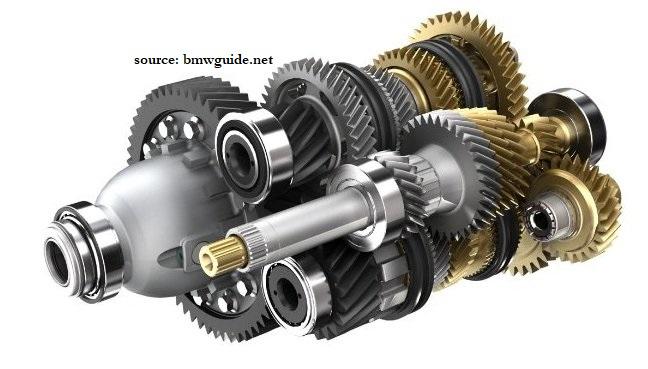
Nearly all machines have some kind of power and motion transmission from an input source. This is usually an electric motor or an internal combustion engine which typically provides rotary driving torque via an input shaft–coupling combination.
Why do we need mechanical power transmission?
There are many ways to generate power but sometimes it is not possible to generate power where it’s needed or in the right form, direction, or magnitude. Hence electrical & mechanical power transmissions are vital for any engineering product design. This article is solely about mechanical power transmission and its elements excluding electrical power transmission. Mechanical power transmission and its elements are used for the following reasons;
- Generated power or energy can be converted into a useful form
- Physical constraints limit the power generation at the place where it is used hence it can be transferred from source to a place where it is needed
- It can be used to change direction and magnitude such as speed or torque
- It can be used to change the type of energy i.e. rotational to linear and vice versa
Mechanical power transmission elements
In an engineering product design such as automation drives, machinery, etc, power transmission and its elements make it possible to match the power source to its operating environment and the condition of the working elements.
Benefits of power transmission elements
- Transmit power efficiently
- The elements help to split and distribute the power source to run several mechanisms such as a single motor running multiple conveyor belts.
- To change rotational speeds
- Reverse the rotational direction from the motor
- Converts rotational movement into linear reciprocating motion
Types of Mechanical power transmission elements
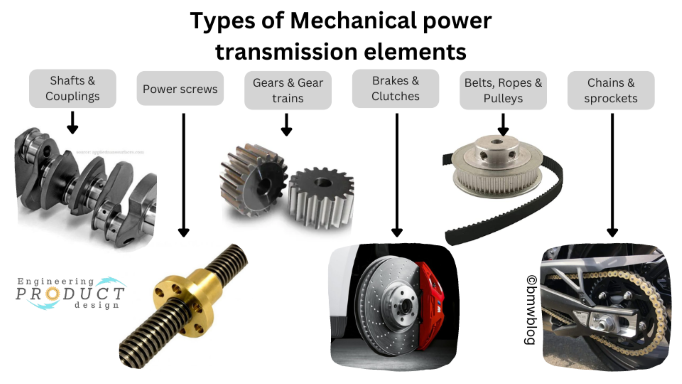
- Shafts & Couplings
- Power screws
- Gears & Gear trains
- Brakes & Clutches
- Belts, Ropes & Pulleys
- Chains & sprockets
Shafts & Couplings
As discussed earlier shafts and couplings are an integral part of the power transmission for modern-age engineering product designs such as machinery. Since power transmission shafts are widely used in almost all types of mechanical equipment design, the design is critical for the safe and long life of the machines.
Shafts
A mechanical shaft is a mechanical power transmission element that conveys power and rotational motion from one device to another. Shaft design is critical to avoid any premature failure and the designer should consider the common failure modes.
Sub-components such as couplings, bearings, pillow blocks, gears, pulleys, sprockets and Clevis pin joints are mounted onto a shaft to transmit power or rotation via the central portion of the component called hub along with retention devices such as keys and splines. The connection should ensure that connection transmits the load, power & rotation without slipping and within the accuracy requirement of the design.
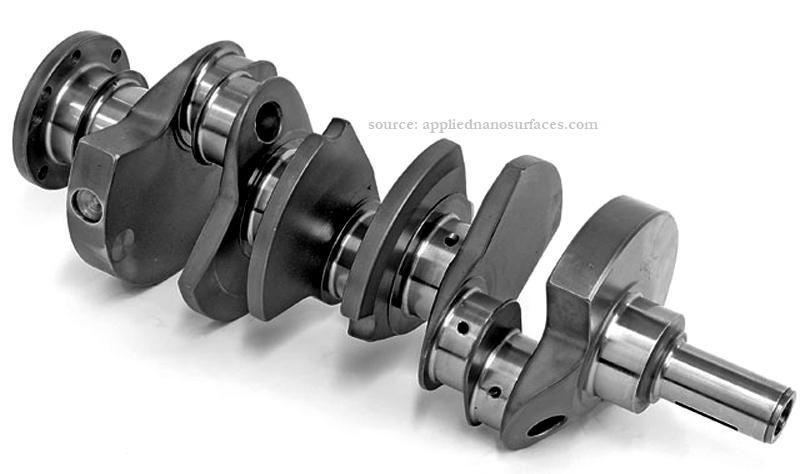
Types of connections and components required to be used along the shaft axis are dictated by the functional requirements of the product and depend on the following factors
- Magnitude of Torque
- Shaft size
- Rotation speed
- Direction of rotation
Couplings
Couplings also known as shaft couplings are used to connect two shaft ends together to transmit both angular rotation and torque. The main design requirement for couplings and their retention devices is that the rated torque must be transmitted without slip, premature failure or in some cases it needs to withstand misalignment.
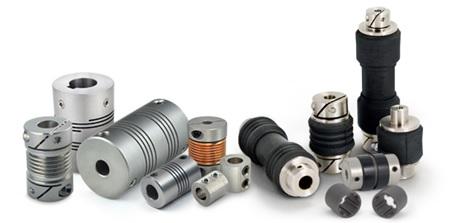
Mechanical power transmission couplings are typically divided into two broad categories
- Rigid coupling
- Flexible coupling
Rigid couplings are simple, easy to design, and comparatively cheap though require precise alignment of the shafts, whereas flexible couplings can accommodate shaft misalignment.
Power Screws
A Power screw also known as Leadscrew ( or lead screw) and translation screw, is a screw used as a power transmission linkage element in an engineering product such as a machine to translate rotational motion into linear motion. The large area of sliding contact between the male and female parts of the screw threads provides a large mechanical advantage via the small wedge angle.
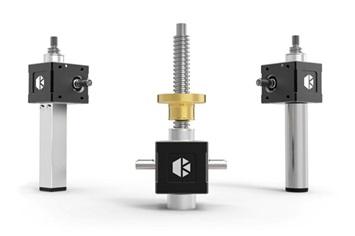
Power screws have many applications such as linear leadscrews, machine slides, vices, screw jacks, mechanical press steering mechanisms, etc. Most common arrangements are set up such that the power screw rotates and the nut translates into linear motion along with the screws. But it’s also used in an opposite orientation such as the screw jack where the nut rotates and the screw moves linearly to raise the jack.
These are not used on high-power transmission because of large frictional energy losses on screw threads but are used on low-power intermittent transmission such as low-accuracy positioners.
Gears and gear trains
Gear trains are multiple sets of gears that transmit power. A gear train is a mechanical power transmission system where gears are installed on shafts so the teeth of the mating gears engage and each roll on each other on its pitch circle diameter.
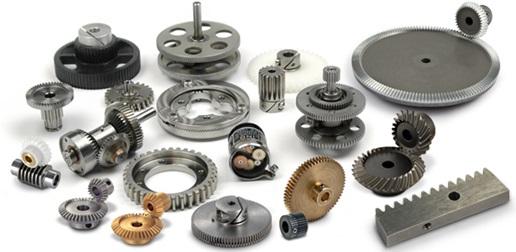
The speed ratio and mechanical advantage of mating gears are defined by the pitch circle diameter ratio.
Brakes and Clutches
Theoretically, brakes and clutches are nearly indistinguishable, though functionally clutches are couplings that are used to engage and disengage the transmitted power between two connecting shafts rotating at different speeds on a common axis. The main function of a clutch is to bring both elements to a common angular velocity.
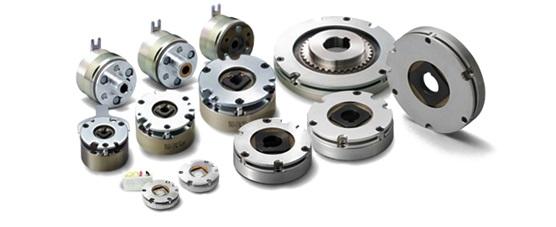
A brake functions in a similar manner, except that one of the elements, is fixed, so when actuated the common angular velocity is zero.
Although brakes and clutches are known for their automotive application, it’s also widely used in winches, mowers, hoists, washing machines, tractors, mills, elevators and excavators.
Clutches
Mechanical clutches can be classified and distinguished in a variety of ways depending on their engagement type, operating principle, type of actuation & method of operation
| Engagement type | Operating principle | Actuation type | Operation method |
| Positive drive clutches | Closing clutches | Hydraulic actuation | Dry clutches |
| friction clutches | Opening clutches | Pneumatic | Wet clutches |
| Mechanical | |||
| Electromagnetic clutches |
Critical things to consider
- Torque transmitted
- Actuating force
- Energy loss
- Temperature rise
Brakes
Like the clutches, there are mechanical, hydraulic, pneumatic, and electric brakes.
It can be classified according to its function :
- Locking brakes, stop brakes
- Regulating brakes
- Dynamometric brakes
- Hydraulic
- electric
Some of the common types of brakes:
- Shoe brakes
- Band bakes
- Disc brakes
- Drum brakes
Belts, Ropes & Pulleys
Belts and pulleys are used when the distance between the shafts is too far apart to use gears.
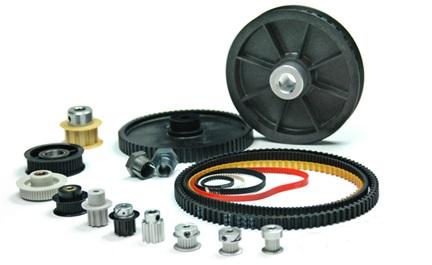
Chain& Sprockets
Chains are used for lower-speed applications where the distance between the shafts is too far apart to use gear trains and belts to support the torque that needs transmitting. They are also a good way of transmitting power when exact speed ratios are needed
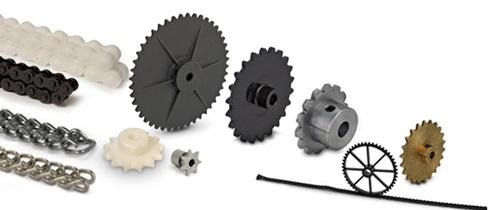
Design tip: Sprockets with an odd number of teeth wear slower than those with an even number of teeth.